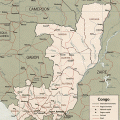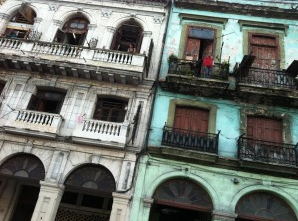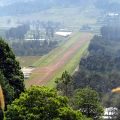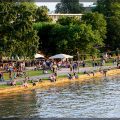Adventures in Yemen

Upon my arrival in Sana’a, the capital city of Yemen, it took a while to get underway. Immigration was uneventful and I had met the guy who would serve as my guide for the next three days, but we had a problem finding a working taxi to take us downtown.
After putting my bag in the back of the first taxi, I went to sit down, but a heated argument was taking place between the guide and the driver. Finally it was determined that this driver was attempting to extort us, so I retrieved my bag and we walked further down the road, where cheaper taxis were available.
My guide flagged down another taxi and negotiated a better price, but we then had a flat tire a couple of kilometers out from the airport. Bummer. The fixer flagged down another taxi, we hopped in, and another kilometer later he ran out of gas. Bummer.
The fourth taxi successfully delivered us to the hotel, and I made plans for touring over the next two days.
***
I first thought that getting to Yemen required a lot of effort, but in the end it mostly required a lot of money.
Out of 187 countries visited so far (only 6 to go! whoa!), the most expensive visa was Belarus. Most visas cost less than $100, but when I went to Belarus I had to pay a whopping $420 to enter the country for less than a week. For the past two years and 50+ countries, no country has topped that figure—until now.
Almost every visa service in the U.S. and Canada declines to work on Yemen visas these days, so I had to find another way in. My approval to visit Yemen came from a “fixer,” a local guy who works with journalists, diplomats, and other foreigners who need to visit the country.
The fixer asked for $500 to arrange the visa, and that was just the initial fee. When we set out to see the town next day, I learned that I wasn’t done with all the payouts. Visitors in Yemen must be accompanied by a government minder, who is essentially in charge of ensuring that you don’t ask uncomfortable questions or meet anyone who is critical of the regime. I’ve had minders before, but the Yemen minder model has two unusual characteristics.
First, you have to pay the minder $100 a day for his services. This fee is illegal and goes straight to the minder’s pockets, but if I didn’t pay it, the fixer would likely have gotten in trouble later. I grudgingly handed over the money.
The second unusual characteristic was something I had never seen before: you can pay the minder not to mind you. The fee is mandatory, but after paying it you can send the minder away and go about your business. (Yeah, really!)
I asked the fixer if we really needed the minder. He suggested we leave him behind, so that’s what we did—I paid him to watch over me on behalf of the government, then he got in a taxi and went home. Surreal.
A Brief Note on Visa Applications
Visa applications often ask for your occupation, and I learned long ago never to say I was a writer. For some reason, countries like Yemen aren’t fond of journalists coming to write about the corruption and brutality of the regime that runs the place.
For Yemen, I decided to play it fairly straight. On the application, it asked for the purpose of my visit, and I wrote “Visiting.” When I talked to the guy at the consulate, we had a brief, Kafkaesque interview.
What is the purpose of your visit?
I am visiting.Why do you want to come to Yemen?
Because I would like to visit.You are visiting?
Yes. Visiting.***
Thankfully, the consulate wasn’t that concerned, so he shrugged it off and issued the approval. When I checked later, I enjoyed the fact that my visa was stamped “Purpose of Visit: TO VISIT.”
Because Yemen has been suffering an active civil conflict for the past few years, I was somewhat apprehensive about this trip. Thankfully, my guide was reliable and trustworthy, and I relaxed a bit as we went out to see the sights.
On the ride out of Sana’a we passed by numerous government buildings, some in better shape than others. We drove by the Ministry of Electricity, which the fixer said was a joke. “We haven’t had electricity for years,” he told me, “so now we call it the Memorial of Electricity.”
For a more positive experience, we went up to the Summer Palace, where I enjoyed the fresh air and a look at an older way of life.



We then went to the market, where I learned more about the traditional dagger that all Yemeni men wear on a belt. (The vendors were keen on selling me one, but I foresaw a problem with packing it in my carry-on bag for the next six flights.)
Throughout the rest of the day and for much of the next I heard all about the history of Yemen, the conflict between various parties, how marriages are arranged, and all sorts of other things that I usually leave to more qualified travel writers to explain.
There were two experiences, however, that I found worthy of recording.
#1: Tahrir Square
While we were driving in the downtown area the first day, we passed by a number of tents and makeshift structures that had been set up in the middle of the road. “What’s happening here?” I asked.
“Nothing much is happening now,” the fixer said. “But this is where the revolution started.”
We got out of the car and took a walk. The call to prayer from a nearby mosque was sounding overhead, and a dozen men gathered to face toward Mecca and conduct their prayers.
The fixer pointed out a nearby building. “See where we are standing?” It turned out we were in Tahrir Square, the site of protests during the beginning of the Arab Spring movement in 2011.
Early in the days of protest, when people started massing at the square, hired militia men set up in the building and opened fire on the crowd, shooting people at random. More than fifty people were killed, and the revolution withered. The tents are still there, but some have been converted to shops, and others are largely empty.


The tents reminded me of the Occupy movement, which I had seen in New York and Portland. The obvious difference is that if you’re part of Occupy Wall Street or Occupy London, the government may very well come out to remove you from the property, but they won’t employ assassins to shoot you without warning.
I had a strange sensation while standing in Freedom Square, and felt like I should pay my respects somehow. There wasn’t much I could do, though, so I finally said my own prayer and got back in the car.
Later I read more about the Yemeni Uprising, and the facts seemed to match up with what I was told.
#2: The Drug Deal
I was traveling in Yemen during Ramadan, the monthly period of fasting. During Ramadan, eating and drinking in public during the daytime is prohibited, and the entire culture adapts to a different schedule. People stay up late and sleep until noon. Most social activity takes place after sunset, when everyone gathers to break the fast.
After touring the square and the market, our driver wanted to run an errand: he was in search of his daily supply of khat, which he would enjoy that evening once the fasting was over. Khat is a natural stimulant that serves as the national drug of Yemen (and also in Somalia, Ethiopia, and a few other places). It’s illegal in the U.S., Canada, and much of Europe, but part of daily life in the Horn of Africa.
I had seen khat when I was in Somaliland earlier this year, but I had never been part of the shopping experience. We drove for a while longer, found a khat dealer with an open-air shop, and the deal went down.



Our supply cost $3 and was intended for my fixer and driver, but they gave me a small sample to take back to my room. (Just like with crack, free samples are how you get hooked!)
Unfortunately, my first attempt at chewing khat didn’t go so well. The experience was basically what you’d expect from chewing on a pile of sticks and leaves, and it tasted as good as you might imagine.
I chewed a small supply for about ten minutes, then gave up and went back to answering my email. Such is the life of a hardened traveler! I consoled myself with the fact that at least I got to see a Yemeni drug deal, even if the substance is legal there.
***
After ten years of traveling, I’m glad I finally made it to Yemen. It was country #187, which means there are now just six countries left!
I’m currently traveling back to the U.S. via Europe, where I’ll be working on a new project for the next few weeks. More on that Monday—for now, I hope you’re doing well wherever you are.
– Chris
###
Top Image: Karl







